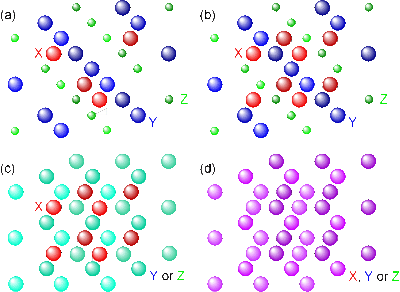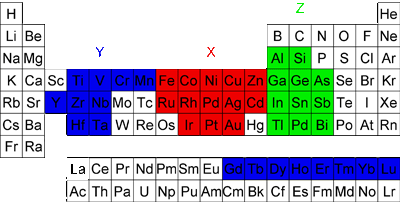ホイスラー合金
Heusler Alloys
 提案されている4種類のハーフメタル強磁性体の中で、ホイスラー合金が室温での100%スピン分極実現に最も近いと考えられています. これはホイスラー合金の格子定数が一般的な基板・下地層に近く、強磁性相転移温度であるキュリー点TCが室温よりもはるかに高く、フェルミ面EF近傍でのバンドギャップが一般に大きいためです. ホイスラー合金は結晶構造に依り2種類に分類されます; ハーフホイスラー合金(XYZ構造でC1b相)とフルホイスラー合金(X2YZ構造でL21相). 右図(a)と(b)にある通り、XとY原子は遷移金属で、Z原子が半導体か非磁性原子(左下図). L21相の単位格子は4つの面心立方格子(fcc)からなり、C1b相はそこからX原子を1つ取り除いた構造です. ホイスラー合金においては、ハーフメタル強磁性が原子レベルでの欠陥に弱いことが知られています. L21相において、YとZ原子で混成が起きた場合(Y-Z混成)、最終的に両者がランダムになるとB2相に変化します[右上図(c)参照]. さらにX-YとX-Z混成が生じると、最終的にA2相に変化する[右上図(d)参照].
Among the four proposed half-metallic ferromagnets, the Heusler alloys holds the greatest potential to realise the half-metallicity at RT due to their lattice constant matching with the III-V semiconductors, high Curie temperature TC above RT and large bandgap at EF in general. The Heusler alloys are categorised into two distinct groups by their crystalline structures; half Heusler alloys with the form of XYZ in the C1b structure and full Heusler alloys with the form of X2YZ in the L21 structure as schematically drawn in the right figures (a) and (b), respectively, where X and Y atoms are transition metals, while Z is either a semiconductor or a non-magnetic metal (see the left figure below). The unit cell of the L21 structure consists of four face-centered cubic (fcc) sublattices, while that of the C1b structure is formed by removing one of the X sites. In the Heusler alloys, the half-metallicity is known to be fragile against atomic disorder. For the L21 structure, when the Y and Z atoms replace their sites (Y-Z disorder) and eventually occupy their sites absolutely at random, the alloy transforms into the B2 structure [the right top figure (c)]. In addition, X-Y and X-Z disorder finally forms the A2 structure [the right top figure (d)].
提案されている4種類のハーフメタル強磁性体の中で、ホイスラー合金が室温での100%スピン分極実現に最も近いと考えられています. これはホイスラー合金の格子定数が一般的な基板・下地層に近く、強磁性相転移温度であるキュリー点TCが室温よりもはるかに高く、フェルミ面EF近傍でのバンドギャップが一般に大きいためです. ホイスラー合金は結晶構造に依り2種類に分類されます; ハーフホイスラー合金(XYZ構造でC1b相)とフルホイスラー合金(X2YZ構造でL21相). 右図(a)と(b)にある通り、XとY原子は遷移金属で、Z原子が半導体か非磁性原子(左下図). L21相の単位格子は4つの面心立方格子(fcc)からなり、C1b相はそこからX原子を1つ取り除いた構造です. ホイスラー合金においては、ハーフメタル強磁性が原子レベルでの欠陥に弱いことが知られています. L21相において、YとZ原子で混成が起きた場合(Y-Z混成)、最終的に両者がランダムになるとB2相に変化します[右上図(c)参照]. さらにX-YとX-Z混成が生じると、最終的にA2相に変化する[右上図(d)参照].
Among the four proposed half-metallic ferromagnets, the Heusler alloys holds the greatest potential to realise the half-metallicity at RT due to their lattice constant matching with the III-V semiconductors, high Curie temperature TC above RT and large bandgap at EF in general. The Heusler alloys are categorised into two distinct groups by their crystalline structures; half Heusler alloys with the form of XYZ in the C1b structure and full Heusler alloys with the form of X2YZ in the L21 structure as schematically drawn in the right figures (a) and (b), respectively, where X and Y atoms are transition metals, while Z is either a semiconductor or a non-magnetic metal (see the left figure below). The unit cell of the L21 structure consists of four face-centered cubic (fcc) sublattices, while that of the C1b structure is formed by removing one of the X sites. In the Heusler alloys, the half-metallicity is known to be fragile against atomic disorder. For the L21 structure, when the Y and Z atoms replace their sites (Y-Z disorder) and eventually occupy their sites absolutely at random, the alloy transforms into the B2 structure [the right top figure (c)]. In addition, X-Y and X-Z disorder finally forms the A2 structure [the right top figure (d)].
 ホイスラー合金のバンドギャップは、X-Y原子間での強いd軌道の混成と考えられています. 単位格子あたりのスピンモーメントの合計Mtは、一般化されたSlater-Pauling曲線に合致することがGalanakisらによって理論的に予測されています: Mt=Zt-18 (ハーフホイスラー合金)、Zt-24 (フルホイスラー合金)、ここでZtは合金内の伝導電子数の合計. この結果ホイスラー合金において磁性、フェルミ面EFでのスピン状態密度などを、Y原子の置換などによって連続的に制御可能となります. よって、3元系ホイスラー合金においては2400通り以上の組み合わせが考えられます.
The origin of the bandgap in the Heusler alloys is attributed to the strong d-band hybridization of the two transition metals X and Y. Total spin magnetic moments per formula unit Mt have been reported to follow the generalised Slater-Pauling curve by Galanakis et al., which is represented as Mt=Zt-18 (half Heusler) and Zt-24 (full Heusler), where Zt is the total number of valence band electrons. This behavior enables us to preferentially control the magnetic properties, the spin DOS at EF in particular, continuously by substituting the Y atoms with the other transition metals as listed in the left figure. Even though there are over 2400 possible combinations to form Heusler alloys, there are about a few tens of alloys reported to become the HMFs according to theoretical calculations on this point.
ホイスラー合金のバンドギャップは、X-Y原子間での強いd軌道の混成と考えられています. 単位格子あたりのスピンモーメントの合計Mtは、一般化されたSlater-Pauling曲線に合致することがGalanakisらによって理論的に予測されています: Mt=Zt-18 (ハーフホイスラー合金)、Zt-24 (フルホイスラー合金)、ここでZtは合金内の伝導電子数の合計. この結果ホイスラー合金において磁性、フェルミ面EFでのスピン状態密度などを、Y原子の置換などによって連続的に制御可能となります. よって、3元系ホイスラー合金においては2400通り以上の組み合わせが考えられます.
The origin of the bandgap in the Heusler alloys is attributed to the strong d-band hybridization of the two transition metals X and Y. Total spin magnetic moments per formula unit Mt have been reported to follow the generalised Slater-Pauling curve by Galanakis et al., which is represented as Mt=Zt-18 (half Heusler) and Zt-24 (full Heusler), where Zt is the total number of valence band electrons. This behavior enables us to preferentially control the magnetic properties, the spin DOS at EF in particular, continuously by substituting the Y atoms with the other transition metals as listed in the left figure. Even though there are over 2400 possible combinations to form Heusler alloys, there are about a few tens of alloys reported to become the HMFs according to theoretical calculations on this point.
さらに興味のある方はFor further reading








